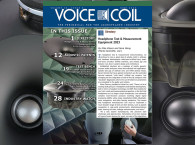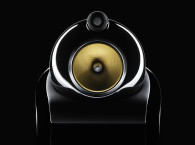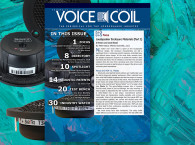 This edition of Voice Coil begins with a Spotlight article on "How to Measure Free-Field Speaker Response without an Anechoic Chamber," written by Steve Temme (Listen, Inc.). As he explains, during this pandemic, one of the biggest challenges with working from home is not having access to an anechoic chamber. So Temme created a short tutorial (and webinar, by the way), explaining a simple solution for this: a “splice” measurement. He says, "This is a long-established technique - I wrote an Audio Engineering Society (AES) paper on the subject back in 1992, and the capability for such measurements has been included in SoundCheck since 2001. Despite its long history, this method has not seen widespread use. However, the current pandemic’s working challenges are sparking renewed interest." A great reference article, and also a new reason to explore Listen's software further. SoundCheck continues to expand in very useful ways.
This edition of Voice Coil begins with a Spotlight article on "How to Measure Free-Field Speaker Response without an Anechoic Chamber," written by Steve Temme (Listen, Inc.). As he explains, during this pandemic, one of the biggest challenges with working from home is not having access to an anechoic chamber. So Temme created a short tutorial (and webinar, by the way), explaining a simple solution for this: a “splice” measurement. He says, "This is a long-established technique - I wrote an Audio Engineering Society (AES) paper on the subject back in 1992, and the capability for such measurements has been included in SoundCheck since 2001. Despite its long history, this method has not seen widespread use. However, the current pandemic’s working challenges are sparking renewed interest." A great reference article, and also a new reason to explore Listen's software further. SoundCheck continues to expand in very useful ways.
For this March edition, Mike Klasco (Menlo Scientific) focuses on loudspeaker enclosures and provides an in-depth look at Plastics and Composites for Audio Products in 2021. This is a topic that Klasco knows extremely well, and one that he is asked frequently to provide consultancy for both large and small brands and manufacturers. As Klasco writes, "Looking back 20 years, fake wood grain vinyl wrapped wood particle-board enclosures were super popular. Then in-walls and inexpensive home-theater-in-a-box moved onto the scene, followed by soundbars, and more recently smart-speakers. All of these categories were more of a fit for the less bulky thin-wall injection-molded plastics. Today, plastics dominate in consumer audio yet few of us have any formal education in their selection and design in audio product development." This article is a great introduction to the fascinating world of plastic enclosures and related composite materials - evolving considerably in the past years. A great read for anyone involved in product development and design.
Voice Coil complements this Focus topic with an updated directory of Speaker Enclosure Vendors, compiled by Nora Wong (Menlo Scientific). This is a space where factories have, in general, been expanding "vertically" to supply complete loudspeaker system assemblies. And while many are still on the market as suppliers of speaker cabinets for the mass market, the number of highly specialized and crafted suppliers is getting smaller - and also receiving increased demand. This updated directory lists also vendors that are able to meet requirements for building prototypes and take the process along to volume production of the final design.
In his Acoustic Patents column, James Croft discusses a speaker assembly patent awarded to Daniel T. Lilley, Jr. (Raleigh, NC) as sole inventor and granted on his behalf in 2015. His patent describes a speaker assembly for low-frequency sound that is able to direct the sound in any direction desired, by use of an acoustic dipole. "The speaker assembly beneficially provides a significantly improved low frequency sound quality, while reducing sound and vibration transmitted to an adjacent space via an airborne or structure-borne pathway," the abstract details.
As someone with an extended knowledge of open finite-baffle loudspeakers and the historical efforts related with exploring its merits, in this review James Croft provides a very comprehensive overview of this design topology which, as he notes, in general has been "brushed aside as having poor low-frequency capability due to the open baffle being an acoustic short circuit at low frequencies and also very ragged frequency responses for circular or symmetrical baffles with the transducer mounted in the center." Interestingly, as he also notes, this patent proposes an effective solution precisely for controlling the lower frequency range, including a preferred embodiment that uses speaker drivers positioned and mounted in a nested matrix, which allows for a smaller design that is acoustically efficiency and with increased dynamic range capabilities. Highly recommended reading.
And this month's Test Bench serves a generous dose of speaker driver characterizations, focusing on two very recent - and completely different - high-frequency designs. First up is the new D2404/552000 Ellipticor Tweeter from Scan-Speak.
In earlier editions, Voice Coil introduced the Scan-Speak Ellipticor drivers with its unique oval (elliptical) voice coil shapes to defeat cone and dome standing wave modes. With the design and concept becoming extremely popular in the high-end two-channel market when it was introduced, the elliptical-shaped series of Scan-Speak drivers continues to expand and the company now has five Ellipticor models. The new D2404/552000 Ellipticor 24mm tweeter is the little brother to the D3404 tweeter, already characterized in a Test Bench in Voice Coil, April 2018. This new device uses a scaled down D3404 Air-Circ tweeter motor with eight neodymium slugs, and includes a copper shorting ring (part of the patented Symmetrical Drive SD-2 motor format) and a titanium former. Other features include a coated cloth elliptical dome, aluminum face plate, gold-plated terminals, and a very slick aluminum trim ring that covers the mounting screws.
 The second driver in Test Bench is the New AT60NC-4 AMT Tweeter from SB Acoustics’ Satori Line. This new high-frequency driver follows the recent “renaissance” of Air Motion Transformer (AMT or Air Velocity Transformer aka AVT) over the last several years, and we now find AMTs used not only in home audio (MartinLogan, Wharfedale, Emotiva), but also in pro sound, in both studio monitors (Adam, Presonus, HEDD, Eve Audio) and AMT drivers for PA applications such as the Beyma TPL-200/H. The Satori AT60CN-4 is targeted at high-end audio applications, designed in Denmark by Danesian Audio and manufactured by SB Acoustics in its purposely built Satori assembly in Indonesia. Its features include a damped foil and Kapton 43mm × 29mm pleated AMT diaphragm, an optimized rear chamber, two-part face plate, 91dB sensitivity, and a diaphragm area (Sd) of 12.6 cm2, just somewhat smaller area than a 30mm dome tweeter. See how it measures!
The second driver in Test Bench is the New AT60NC-4 AMT Tweeter from SB Acoustics’ Satori Line. This new high-frequency driver follows the recent “renaissance” of Air Motion Transformer (AMT or Air Velocity Transformer aka AVT) over the last several years, and we now find AMTs used not only in home audio (MartinLogan, Wharfedale, Emotiva), but also in pro sound, in both studio monitors (Adam, Presonus, HEDD, Eve Audio) and AMT drivers for PA applications such as the Beyma TPL-200/H. The Satori AT60CN-4 is targeted at high-end audio applications, designed in Denmark by Danesian Audio and manufactured by SB Acoustics in its purposely built Satori assembly in Indonesia. Its features include a damped foil and Kapton 43mm × 29mm pleated AMT diaphragm, an optimized rear chamber, two-part face plate, 91dB sensitivity, and a diaphragm area (Sd) of 12.6 cm2, just somewhat smaller area than a 30mm dome tweeter. See how it measures!
And this edition also includes the usual dose of Industry Watch highlights, selected by Vance Dickason.
The March 2021 edition of Voice Coil is available for download and already in the mail to print subscribers. Subscribers can go to - www.gotomyvcoil.com - to download this issue.
Remember, Voice Coil is available in print and download for all registered subscribers, free for industry professionals. To qualify for a free subscription to Voice Coil, or renew your subscription, go to: audioxpress.com/page/Voice-Coil-Subscriber-Services.html
Access to Digital Subscriptions
The pandemic has affected everyone’s lives, including those who provide our delivery service. With a surge in delivery demands and travel restrictions, we realize some of you may be experiencing significant delays in receiving your magazines. So KCK Media opened up its digital subscription platform to all print subscribers for no additional fee. To access it, just login using your subscriber number and post/zip code as displayed on your mailing label.

- on Magazine News
- News
Loudspeaker Knowledge Inside and Out in Voice Coil March 2021
February 26 2021, 11:10
In this edition of Voice Coil, Steve Temme explains "How to Measure Free-Field Speaker Response without an Anechoic Chamber," Mike Klasco writes about "Plastics and Composites for Audio Products in 2021," and there's an updated Speaker Enclosure Vendor Directory. James Croft provides a fascinating patent review of a speaker assembly design for low-frequency control using an acoustic dipole. And Vance Dickason characterizes two new tweeters: the D2404 Ellipticor Tweeter from Scan-Speak, and the Satori AT60NC-4 AMT Tweeter from SB Acoustics. Now available in print and online!





